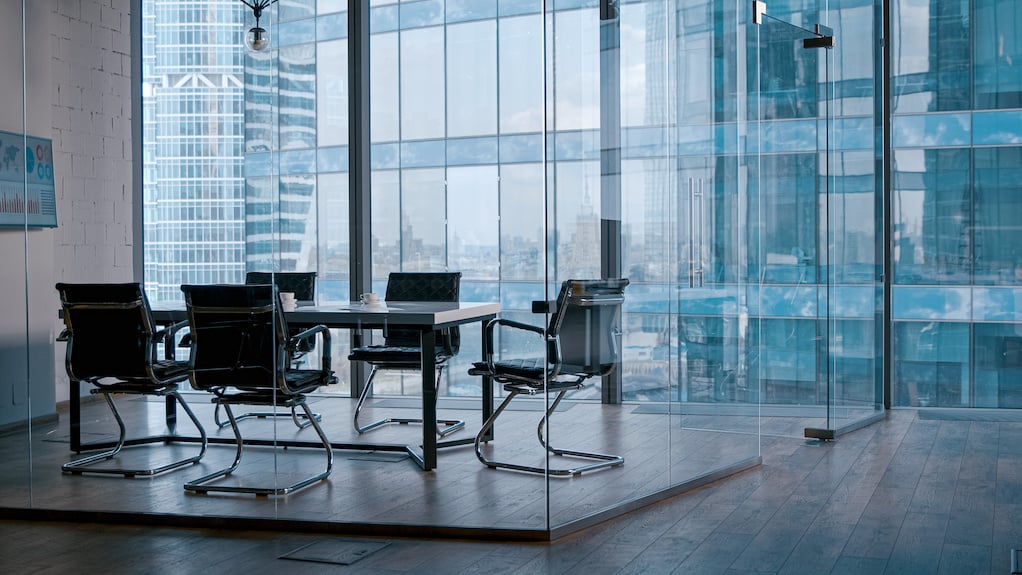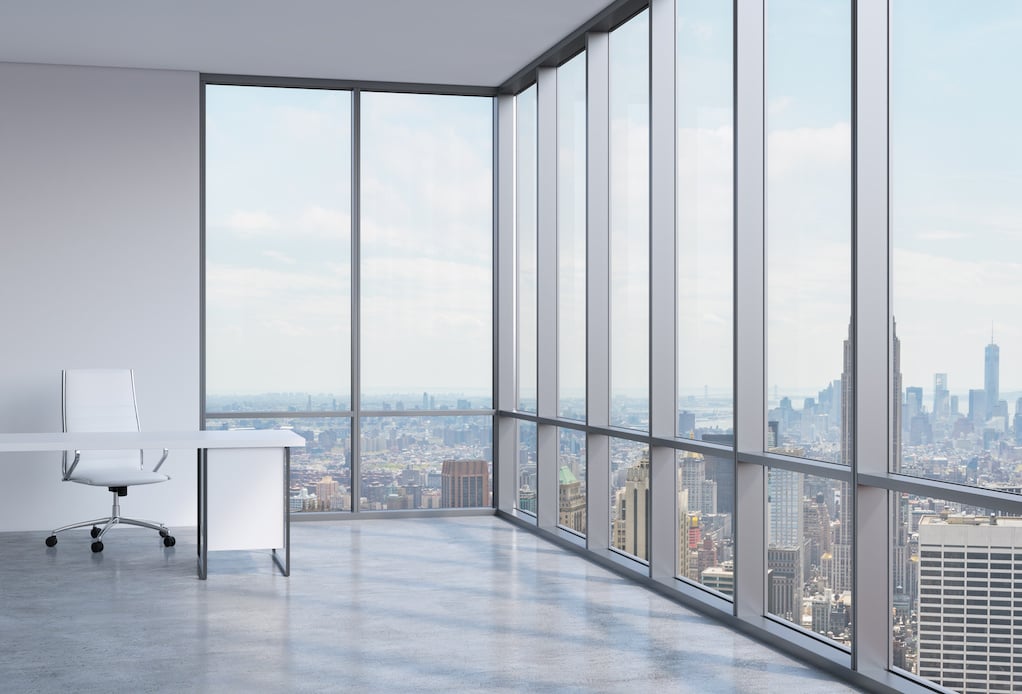The coveted corner office is a ubiquitous status symbol. The prime real estate, reserved for upper management, speaks to the traditional preconceptions we held about corporate environments.
But with less emphasis placed on the office in general, the contextual clues of a corporate space’s structure are evolving.
And with any evolution comes an inevitable extinction of what no longer serves an essential purpose. So, in terms of the corner office, maybe we’re not seeing an extinction, but an endangerment. The corner office has been devalued, let’s explore the reasons why.
Work From Home
The discussion obviously begins with the newfound work/life flexibility that Americans received in the pandemic. As a collective, we got a taste of life without two-way commutes, traffic, and long days in the office. And now three years later, most are unwilling to give up this quality of life.
And why should we?

Americans have sustained measures of expected productivity, even exceeding some prior metrics. This proved that WFH is not only a feasible solution but holds long-term merits for not only quality of life but productivity.
And on the employer side, remote arrangements are a massive money-saver. Commercial real estate is typically one of an organization’s top costs, so cutting down a footprint is one of the most effective ways to reduce the strain on an organization’s EBITDA. Accordingly, many companies have slashed their square footage and opted for an indefinite WFH schedule.
Rooted in this freedom, unsurprisingly, a lot of people moved. With no office to tie you to a geographical radius, you can reevaluate your living conditions.
Because at the same time that this was occurring, the divide between states that encouraged economic growth and challenged growth worsened. For many, it made no sense to be located in areas of high expenses (often CBDs) where their offices may have been.

Given the freedom to be mobile, Americans took advantage and moved in record numbers. “Some 46 million people moved to a different ZIP code between February 2021 and February 2022 — the most of any 12-month period since 2010 — according to a new analysis by Moody's Analytics shared with Axios and first reported by the Wall Street Journal.” Learn The Top 5 States Americans are Moving to.
So, with everyone fleeing the area, no one’s showing up to the office. Of course, there are companies that do prefer in-person working arrangements. But, it is undeniable that the way we consider corporate spaces and status has fundamentally changed. With a vast majority of Americans working at least a hybrid schedule, these tectonic plate shifts are likely to be irreversible.
Broadband
While a great majority would credit the Office Apocalypse to COVID-19, there were other circumstances at play that need to be acknowledged.
If COVID was the match that changed the way we work, the bucket of gasoline was fast broadband. Without the technological revolution of the past decades, work from home obviously wouldn’t be a possibility, let alone the norm.

COVID was the first time (on a grand scale) that Americans could fully utilize the tools and technological structures before them that were already built into our systems. And fully in action, it was powerful enough to keep the world moving without any losses to productivity.
|
Ubiquitous, fast, reliable, and cheap broadband has ripped away the need for a CBD. |
Consider that it only takes 4 - 5 mega bits for a zoom call per second. The average American household has access to upwards of ten times this capability. Check your's at Speed Test. It was only a matter of time before technological development would reach a threshold that fundamentally changes the way we work and live.
Right-Sizing and Office Space Cuts
Like discussed, companies have been taking advantage of what the WFH revolution means for corporate spending. Because really, does it make sense to pay for a premium, CBD office if less than half of employees are going to work each day?
Businesses are taking a hard look at the efficiency of their corporate spaces. If it’s still in their best interest to have an office, it likely looks and functions a bit different. There’s been a big push to reorient the traditional office to accommodate the growing hybrid workforce.

Part of this is cutting away the fat in a portfolio and the overall square footage needed by an organization. Doing so can potentially save a company millions over a lease term. Learn more about Right-sizing.
Now, rather than devote the most square footage to those with the most influence, it’s devoted to whoever is showing up to work in person. The CCIM predicts that going forward, “The percentage of real estate that workers occupy actually will be based on how much time they spend in the building.”

Now, consider that 10-25% of an office’s square footage can be eaten up by corner offices, according to Propmodo. In a new standard of spatial utilization efficiency, this represents a significant portion of a company’s footprint that could perhaps be used in novel ways to a corporate advantage. Spaces reserved for individuals can be devoted to the collective good of an office, in line with the new emphasis on such spaces being efficient and multi-functional.
Now, according to Propmodo, “Companies are eliminating private offices and redesigning their office spaces to give conference rooms and lounge spaces more of the coveted window space.”
This is all part of the new normal we’re living in. To be a more competitive recruiting force in the war for talent, businesses are considering how to make their offices more engaging to potential or current team members. If a space clearly shows care for the comfort of the people visiting it, you’re more likely to earn employee loyalty.
|
"Flexibility has created its own hierarchy." -Propmodo |
Propmodo continued that, “Companies are investing time and resources into workspaces that people can reserve with smart building technology, putting less emphasis on differentiating individual status and more emphasis on democratizing space.”
So, as we evolve to accommodate new working schedules, so do the contextual clues of a space’s hierarchy. There is more emphasis placed on the employee experience when they do visit the office rather than maintaining traditional ideas of how an office should be laid out.
The Likelihood of a Mass Return-to-Office
So, will the corner office ever regain its superstar status? While there are always power cues built into our structures, for the time being, the pull of the corner office has been devalued. And with workplace occupancy stalling around ~50% of what it used to be pre-pandemic, it’s unlikely that anything will greatly change for the foreseeable future.
As a whole, companies are downgrading their footprints. So, big open (and mostly unused) spaces are the first on the chopping block. Space capitalizers are being traded in for more efficient use of the square footage. This is likely to continue, because flexible working arrangements have been proven to be beneficial for the employee and enlightened employer alike.

It is worth mentioning though, that if our country’s economic circumstances devolve significantly, there may be change on the horizon. A deep recession that forces up unemployment would potentially give employers (that prefer in-person collaboration) a stronger position to mandate workers returning to the office. That being said, even if this is the case, it would likely not have far reaching ramifications. With occupancy rates stalled around 50%, such action would not completely turn around these metrics. Even if the needle was moved 10 - 15%, there’s been an irreversible precedent set.
Because at the end of the day, a lot of employers like maintaining a WFH or hybrid schedule. It’s one of the biggest opportunities corporations have ever seen to cut costs. And additionally, now those same employers can recruit talent on a national (if not global) basis.
So, it’s not going anywhere soon, and neither are the effects on the contextual relationships that exist in office space utilization.
Right-Size with a Tenant Rep
By rethinking their space, businesses are making their CRE spending go further. With not everyone in the office all the time, they can reduce their overall square footage — while increasing the square footage per team member (who is in the office).
If your business is looking to Right-size according to a hybrid-friendly workplace, you should work with a True Tenant Rep™. A Tenant Rep can help you strategically evaluate your properties and where you have room to expand or down-size. Then they will negotiate on your behalf to get you the best deal. Truthfully, the effects of Right-sizing are most successfully achieved when in collaboration with the other two R’s: Renegotiating and Relocating. Learn how the Three R’s can dramatically reduce your CRE costs in a Recession.
At iOptimize Realty®, we are true True Tenant Reps™ with 30+ years of market intelligence. We believe it is a critical responsibility of businesses to remain at the forefront. We have identified how critical including modern features in the offices of our corporate clients. And we can help you benefit the same way. Reach out to learn how we can help today.








